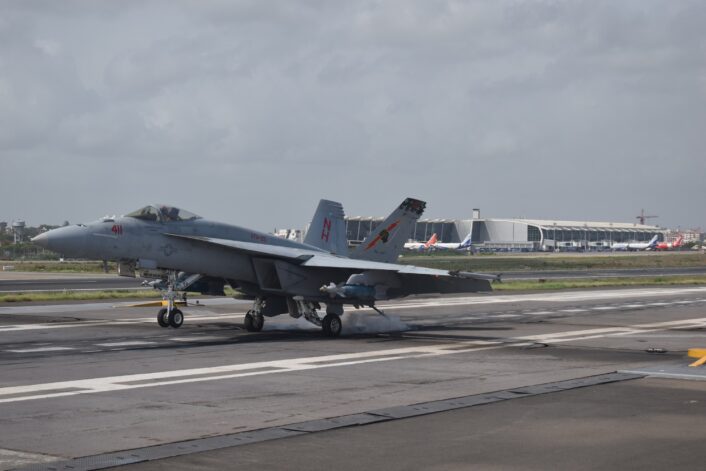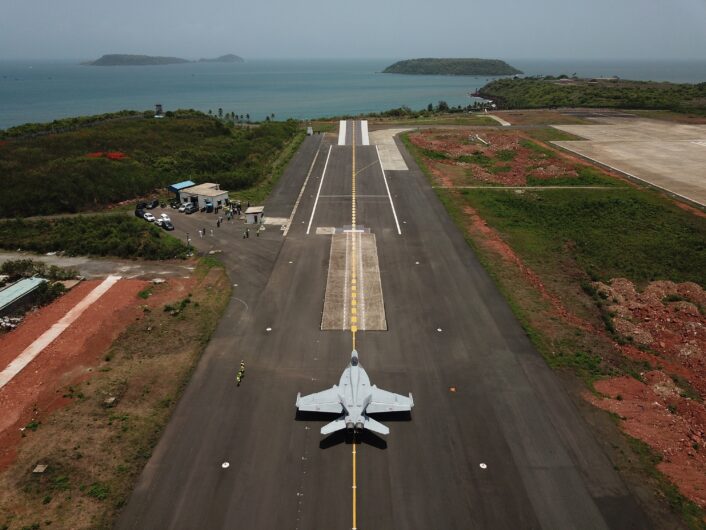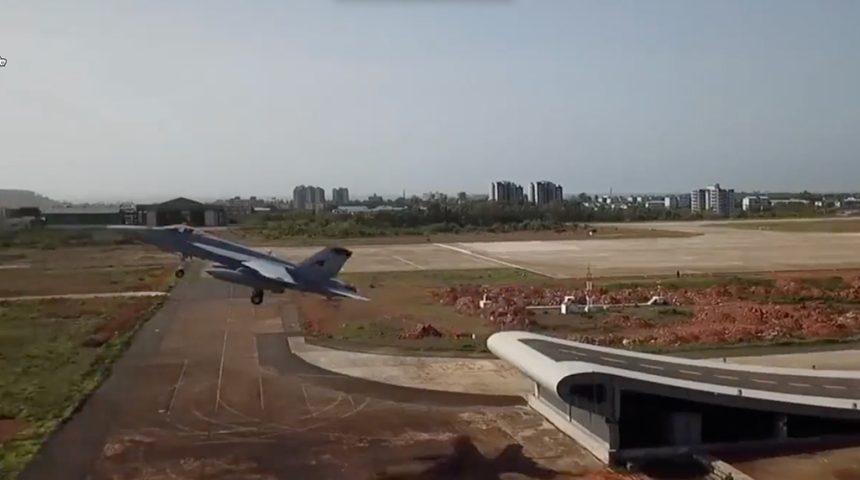The aircraft completed multiple ski-jumps, roll-in and fly-in arrestments to demonstrate compatibility to Indian Navy requirements.
Boeing announced on Jul. 20, 2022, that its F/A-18 Super Hornet successfully completed operational demonstration tests at Indian Naval Station Hansa in Goa, India. The tests were aimed at showing the Super Hornet’s ability to effectively and safety operate off Indian Navy STOBAR (Short Take-Off But Arrested Recovery) aircraft carriers, such as the INS Vikramaditya and the under-construction INS Vikrant, complementing its MiG-29K Fulcrums.
Two U.S. Navy F/A-18E Super Hornets, one of those sporting the markings of Strike Fighter Squadron (VFA) 25 “Fist of the Fleet” based at Naval Air Station Lemoore, California, “completed multiple ski-jumps, roll-in and fly-in arrestments, as well as performance flights, in a variety of weights in the air-to-air, air-to-ground, and air-to-surface configurations, meeting the Indian Navy test requirements.”
Our F/A-18 #SuperHornet successfully demonstrated the ability to safely operate from @indiannavy aircraft carriers during operational tests at INS Hansa, Goa. #FIA2022 pic.twitter.com/ePukceACSh
— Boeing India (@Boeing_In) July 20, 2022
“The Boeing team was privileged to showcase the F/A-18 Super Hornet’s compatibility with Indian carriers in Goa,” said Alain Garcia, vice president, India business development for Boeing Defense, Space & Security and Boeing Global Services in a statement released by the company. “As the most advanced frontline multi-role naval fighter, the F/A-18 Super Hornet is one of the world’s most proven and affordable multi-role fighters and continues to evolve with the development of the next-generation Block III capability which will be game-changing for India.”

“With the Super Hornet Block III, the Indian Navy would not only get the most advanced platform but would also benefit from tactics, upgrades and knowledge related to the naval aviation ecosystem that the U.S. Navy offers,” he added.
The field tests in India follow the eight ski-jump take offs from the ramp at Pax River conducted in December 2020. As we explained back then, that wasn’t the first time a Hornet carried out ski jump take offs. An Air Force Systems Command, dated 1991, says that between 1982 and 1986 “a metal ramp was constructed that could be modified to give ramp exit angles of 3, 6, and 9 degrees. The ramp was 112.1 feet long and 8.58 feet high at ‘he exit when configured for the 9 degree exit angle, measured from the horizontal. A total of 112 launches of the T-2C, 28 of the F-14, and 91 of the F/A-18 were made. The minimum ground roll for the F/A-18 was 385 feet at a gross weight of 32,800 lbs. This ramp effectively reduced the takeoff roll of the F-18 by more than 50 percent.”
The one offered to India, for a contract estimated in 2017 to be worth at least 6.6B USD before the number of aircraft was cut from 57 to 26 fighters, is the advanced Block III Super Hornet. It features an advanced cockpit for improved SA (Situational Awareness), new computing & advanced data link, conformal fuel tanks, SATCOM connectivity, block II IRST (Infra-Red Search and Track), increased airframe lifetime as well as the possibility to team up with the Indian P-8I.

However, the Boeing offer faces the still competition of Dassault: the carrier-based Rafale M conducted compatibility tests similar to those carried out by the Super Hornets in January 2022 and, even more important, the French company already has a success story in India, where they were able to sell the land-based Rafale to the Indian Air Force as part of an 7.87B Euro contract to procure 36 fighters in 2016.









